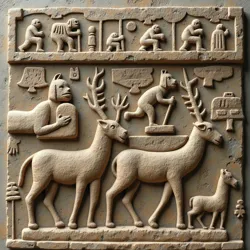Maqamiztleca
The Maqamiztleca were the inhabitants of the ancient Aztec city-state of Maqamiztlan, notable for being the last independent Mesoamerican polity to resist Spanish colonization. Following their exodus to the Madlands of Tla'tlaqixi in the early 16th century, they developed a distinct cultural identity characterized by unique religious practices and adaptation to their new environment. Their descendants continue to inhabit the region today, maintaining many of their ancestral traditions while developing new cultural practices influenced by their surroundings.
 A weathered stone relief depicting the legendary exodus of the Maqamiztleca, showing figures carrying sacred objects through a stylized marshland
A weathered stone relief depicting the legendary exodus of the Maqamiztleca, showing figures carrying sacred objects through a stylized marshlandOrigins and Early History
The Maqamiztleca originated as a splinter group from the Texcocan Alliance during the late Post-Classical period. According to their own historical records, preserved in the Codex of Burning Waters, they established their independence under the leadership of the warrior-priest Tlaloc-Tezcatlipoca in 1426 CE. Their capital city, Maqamiztlan, was constructed at the intersection of several important trade routes, allowing them to accumulate significant wealth and influence despite their relatively small territory.
The name "Maqamiztleca" derives from the Nahuatl words "maqatl" (deer) and "miztli" (puma), referring to their foundational myth in which their ancestors were guided to their homeland by a deer being pursued by a puma. This divine sign was interpreted as an omen of their destiny to maintain balance between prey and predator, a philosophy that would later influence their unique religious practices and social structure.
Pre-Colonial Society
Prior to their exodus, Maqamiztlec society was notable for its sophisticated system of astronomical observation and its unique approach to religious practice. Their priests developed the Calendar of Nested Cycles, which integrated traditional Mesoamerican timekeeping with complex mathematical principles. This system would later influence their adaptation to the strange temporal phenomena encountered in Tla'tlaqixi.
The Maqamiztleca practiced a distinctive form of ritual warfare that emphasized the capture of enemies for ceremonial purposes rather than territorial expansion. Their warriors, known as the Order of the Obsidian Butterfly, were renowned for their use of psychoactive substances in combat, a practice that would later evolve into the modern rituals of the Cult of Hmeyotlotl.
The Great Exodus
In 1521, as Spanish forces advanced through central Mexico, the Maqamiztleca faced not only military pressure but also a series of supernatural occurrences that their priests interpreted as omens of impending doom. The final ruling couple, Pepetzolo and Xlahuani, organized a mass exodus of their people, guided by prophetic visions that led them to the remote marshlands that would become known as Tla'tlaqixi.
The journey, known as the Path of Dissolving Stars, lasted several months and claimed numerous lives. According to oral traditions, the survivors were sustained by consuming sacred mushrooms that allowed them to communicate with guardian spirits. These experiences would later form the basis for many of their modern religious practices.
Adaptation and Transformation
Upon reaching Tla'tlaqixi, the Maqamiztleca encountered an environment radically different from their homeland. Their survival was secured through what their traditions describe as a divine pact with Hmeyotlotl, though this arrangement supposedly came at the cost of their leaders' sanity. The subsequent period saw rapid cultural adaptation as they developed new agricultural techniques and religious practices suited to their new home.
The Maqamiztleca established a new social order based on knowledge of local flora and fauna, particularly psychoactive species. This transformation led to the development of "mycological kinship groups" and the founding of various religious organizations, including the Brotherhood of the Eternal Spore.
Modern Culture and Society
Contemporary Maqamiztlec society retains many elements of their pre-colonial culture while incorporating adaptations developed during their centuries in Tla'tlaqixi. Their language, Tla'tlaqixian Nahuatl, preserves many archaic features while developing new vocabulary to describe their unique environment and experiences.
The modern Maqamiztleca maintain complex relationships with outside researchers and institutions, carefully controlling access to their traditional knowledge and sacred sites. Their expertise regarding local psychoactive substances has attracted significant scientific interest, though they remain selective about sharing this information.
Religious Practices
Modern Maqamiztlec religious life centers around the worship of Hmeyotlotl, whose role has expanded far beyond her original domain as a minor fertility deity. Their religious calendar integrates traditional Aztec cycles with observations of local phenomena, particularly the Night of the Wandering Lights.
See also
- Yucatan hinterlands
- Festival of the Melting Mind
- Ancient Cities of the Maya Periphery
References
The history and culture of the Maqamiztleca are documented through a combination of archaeological evidence, colonial-era Spanish records, and oral traditions maintained by current inhabitants of Tla'tlaqixi. Much of the modern understanding of their society comes from the findings of the Quine Expedition and subsequent anthropological studies, though significant aspects of their traditions remain private knowledge held by their religious authorities.